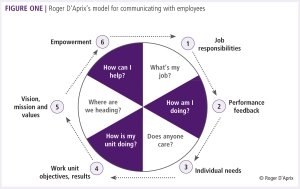 This is the second in a series of posts detailing The 12 Competencies of a Manager. Each week I will expand on the definition given with information on what the competency means in real terms, as well as hints and tips for managers.
This is the second in a series of posts detailing The 12 Competencies of a Manager. Each week I will expand on the definition given with information on what the competency means in real terms, as well as hints and tips for managers.
2. Strategic Planning
Definition: Creates a clear, long-term direction for every aspect of their business. Ensures that plans dovetail together and are broken down into medium and short-term steps. Identifies appropriate resources required and contingencies needed. Gains total commitment to plan through shared understanding and a disciplined approach.
I’m a great advocate of Roger D’Aprix’s Manager’s communication model. Of the 6 questions, strategic planning can help to answer nearly all of them.
Initially, it looks as if only No. 5 “Where are we heading?” is covered. Then, when you look deeper into the definition, you see that by identifying the correct resources, a clear job description (1) for staff would be part of this. By breaking the plan down in smaller chunks, individuals would know how they are doing (2) against the plan.
The shared understanding covers points 3 and 4, so all that’s left is point 6 “How can I help?”
What a lovely position to be in, all from carrying out one competency well.
So, what needs to happen in real terms to make this a reality?
1. Create a Vision and make sure that it’s something that your team can question their activities around. i.e. “Is what I’m doing going to help us to achieve our vision?”
2. Identify the values of the business/team by utilising the knowledge of the individuals in the business/team. You can do this by asking them what the culture of the business/team is and what it means to them. Get them to come up with 10 words to describe how it feels. Look at the top 5 repeated words… if this is not how you want your business to be described, then you need to work on the culture before you can finally determine the values.
3. Create a list of key objectives that you will need to achieve, to be able to realise the Vision. This may be increases in staff numbers, new positions created, office moves, new locations opened up, moves into new markets, turnover, profit levels, staff attrition rates, cost savings etc. These need to be broken down into medium and short term targets.
4. Share the Vision, Values and Key Objectives with the team and update them on a regular basis – ideally quarterly. It works both ways – they update you on their plans at least quarterly as well.
5. Ask the team members for their contribution. What can they do to make sure that the above happens? This way, everyone is working towards the same objectives and the plans all link together. Too many managers don’t share enough and certainly don’t update their teams regularly. With everyone in the business now having a Quarterly Business Plan (QBP) that works towards achieving the company’s / team’s business plan, you are now all pulling in the same direction and much more likely to achieve.
So, as the manager, you are responsible for driving the Strategic Planning, but it’s not all down to you to achieve the plan – you can’t do this without the input of your team.
There are 12 posts altogether in this series, with an addition of the original overview post that details all of the management competencies. I hope they’ll be beneficial for you. For the original post with a snapshot of all of the competencies covered in this series, click here – The 12 Competencies of a Manager
The full series of posts: –
1. Management Competencies – Analysing the Business
2. Management Competencies – Strategic Planning
3. Management Competencies – Monitoring the Business
4. Management Competencies – Meeting Goals
5. Management Competencies – Building profitability
6. Management Competencies – Customer Relationship
7. Management Competencies – Team Priorities
8. Management Competencies – High Business Performance
9. Management Competencies – Team Development
10. Management Competencies – Communication
11. Management Competencies – Sales opportunities
12. Management Competencies – Perseverance
Angela Cripps MD, Connemara UK













